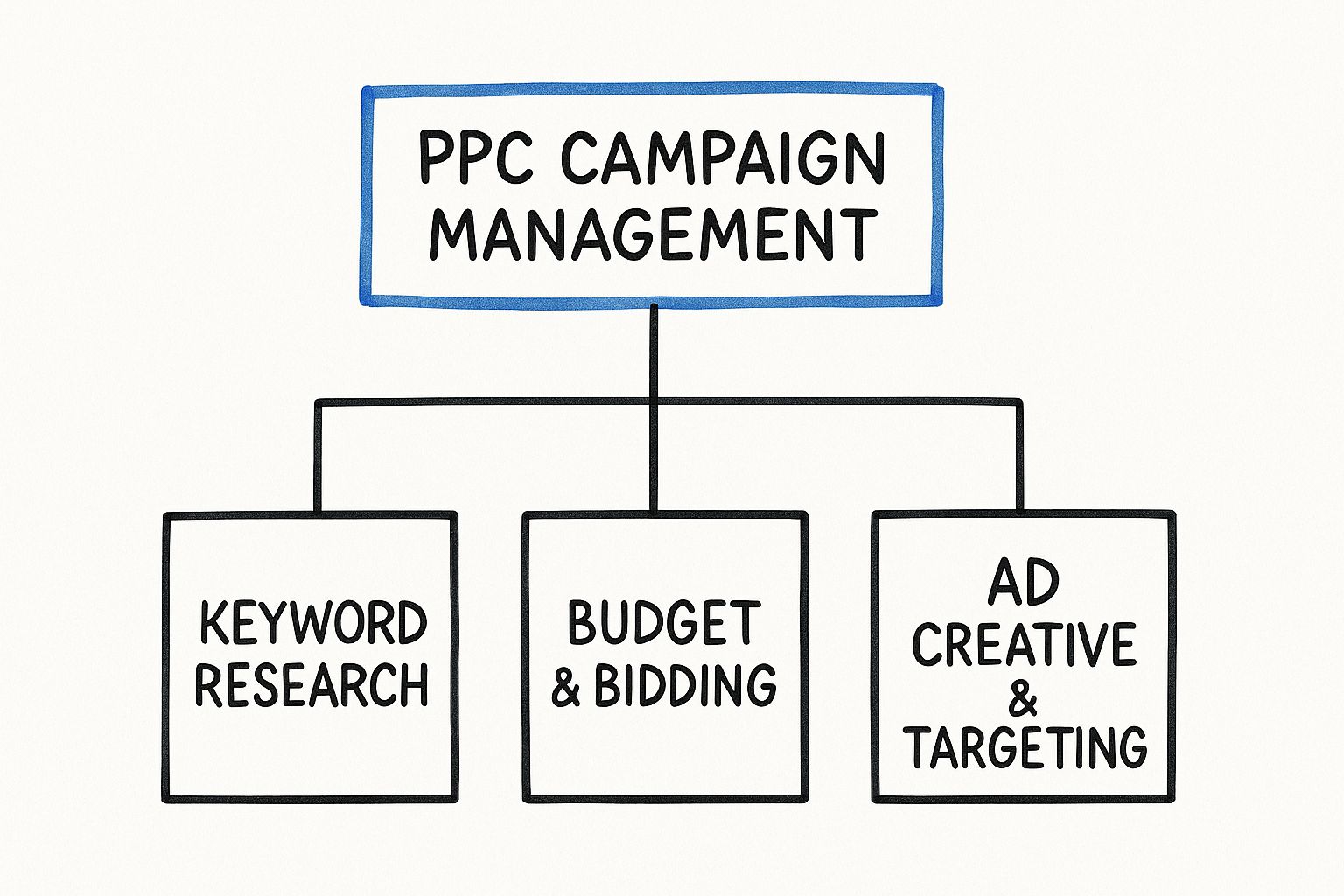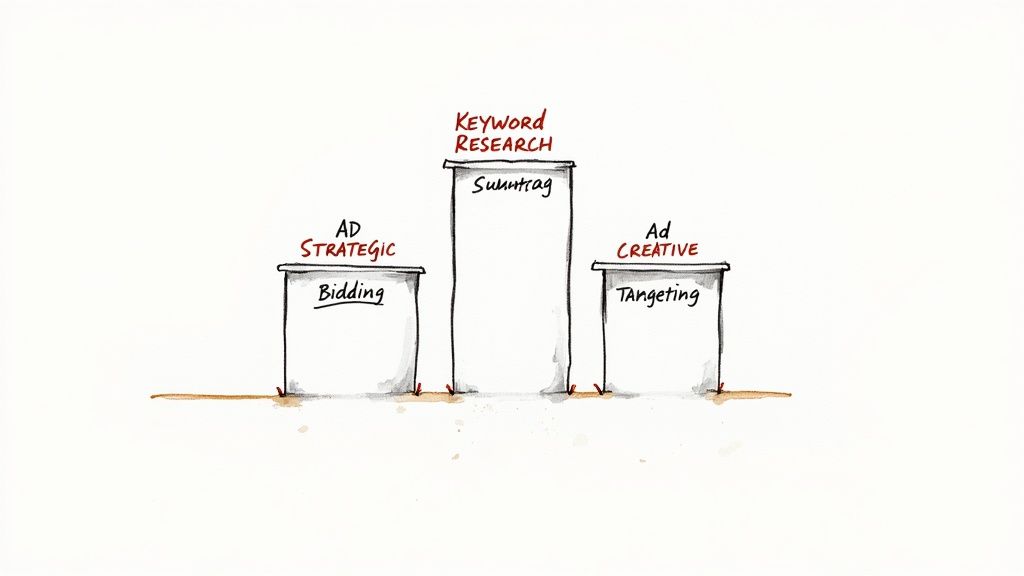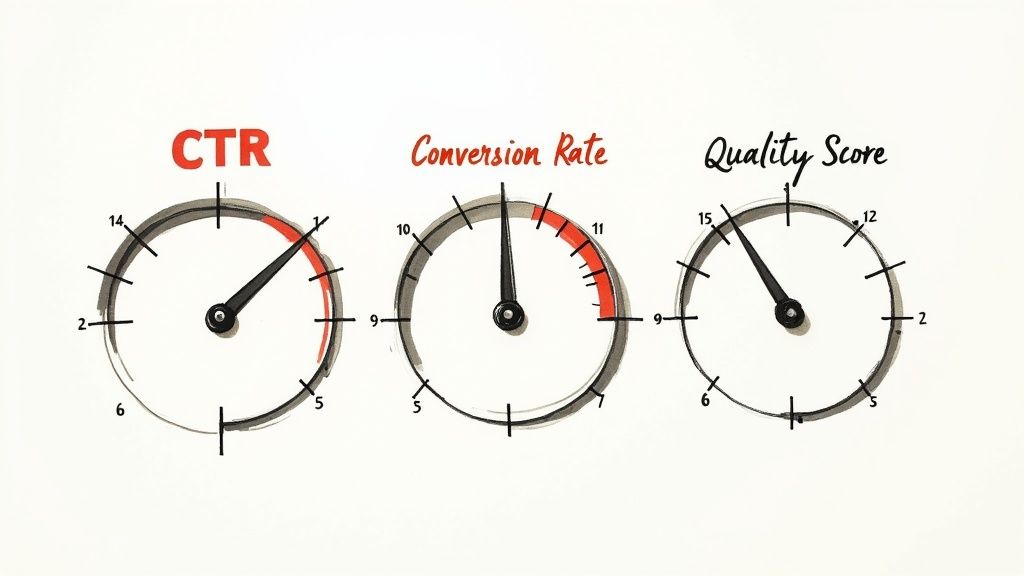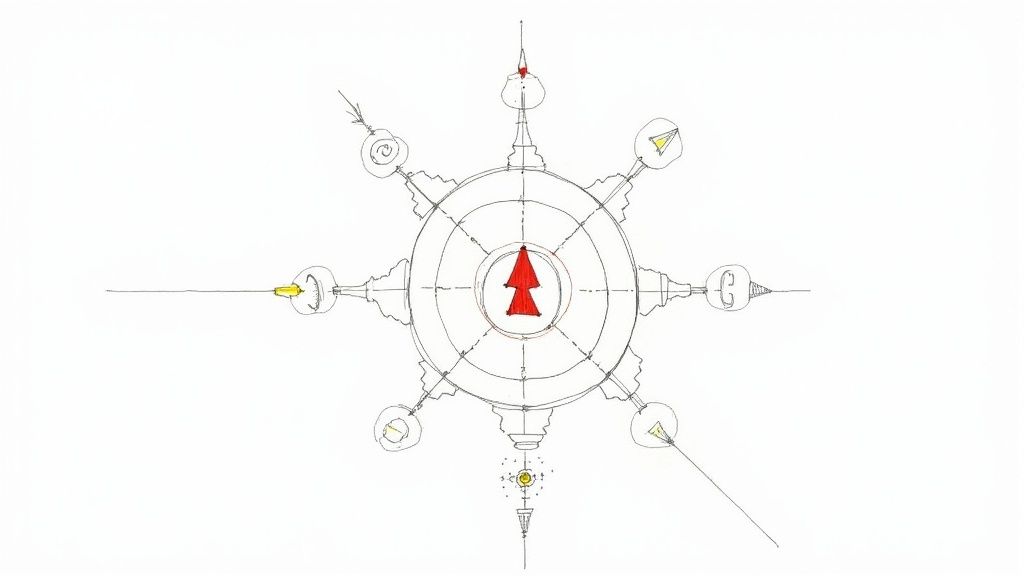Managing a Google Ads campaign is far more than just launching a few ads and hoping for the best. It's the hands-on, continuous process of steering your company's paid advertising, making sure every dollar you spend is working hard to hit your business goals.
Think of it as actively piloting a ship. You wouldn't just point it in a direction and walk away. You’d constantly check the weather, adjust your sails, and navigate around obstacles. The same goes for Google Ads—it requires constant analysis, optimization, and strategic tweaks to get where you want to go, whether that's generating leads or driving sales.
Understanding Pay Per Click Campaign Management in Google Ads
At its heart, pay per click campaign management turns your Google Ads budget from a line-item expense into a powerful growth engine. It's all about stopping the bleed from ads that don't work and doubling down on the ones that do. This is an active, ongoing job.
The Goal of Active Management
A "set it and forget it" approach simply doesn't work in the competitive Google Ads ecosystem. It's a living, breathing cycle of planning, launching, measuring, and refining. The main objectives are always clear:
- Maximize ROI: Ensure the money coming in from your ads is significantly more than the money going out.
- Improve Ad Relevance: Create ads that perfectly match what people are searching for. Google loves this and rewards you with a higher Quality Score, which leads to better ad positions and lower costs.
- Control Costs: Stop wasting your budget on clicks that go nowhere and focus your spend on what's proven to perform.
- Achieve Business Objectives: Tie every part of your campaign—from keywords to ad copy—directly to a specific goal, like more online sales or higher brand visibility.
To really get a handle on the basics, this overview of Pay Per Click is a great starting point.
This infographic breaks down the core pillars of a well-managed campaign.

As you can see, successful PPC management is a mix of creative work and deep analytical tasks like keyword research and bid adjustments.
When done right, the numbers speak for themselves. On average, businesses make $2 in revenue for every $1 spent on Google Ads. That’s a 200% return, cementing its place as a key driver for measurable growth. Budgets can start as small as $100 a month or scale up to over $100,000, which just goes to show how adaptable and essential this strategy is for businesses of any size.
Building Your Google Ads Foundation
A great pay-per-click campaign isn't built on luck; it's built on a solid foundation. Think of it like constructing a house—if you skimp on the groundwork, everything you build on top of it is at risk. In the world of Google Ads, that foundation rests on four key pillars that work in harmony to create profitable, scalable campaigns.
Getting these core components right from the start is absolutely critical. Each one plays a unique role, but they're all interconnected. If even one pillar is weak, the entire structure of your campaign can suffer. Let's break down what they are and why they matter so much.
Meticulous Keyword Research
Think of keyword research as learning to speak your customer's language. It's the process of figuring out the exact words and phrases people type into Google when they’re looking for what you sell. This goes way beyond just picking popular terms; it’s about getting inside their heads and understanding user intent.
For instance, someone searching for "running shoes" is probably just browsing. But a person searching for "buy nike air zoom pegasus 41 men's size 11" is ready to pull out their credit card. Top-tier pay per click campaign management focuses on these high-intent, long-tail keywords to catch people at the exact moment they’re ready to buy. Using Google's Keyword Planner tool is an essential first step.
Strategic Bidding and Budgeting
Bidding is like participating in a smart, fast-paced auction. You're not just throwing money at Google and hoping for the best. You're strategically telling the platform precisely what a click or a lead is worth to your business, which puts you in control of your spending.
Imagine you're at a real-world auction for a rare collectible. You wouldn't just shout out random numbers, right? You’d go in with a maximum price based on what that item is truly worth to you. Google Ads works on the same principle.
Your bidding strategy is a direct instruction to Google's algorithm on how to spend your money. Whether you want to maximize clicks, conversions, or visibility, your bid setting aligns your budget with your business goals and stops you from wasting cash on irrelevant traffic.
Your budget acts as a financial safety net, making sure you never overspend. A recent trend in Google Ads is the increased push towards AI-powered bidding strategies like Performance Max (PMax). These campaigns use machine learning to adjust bids in real-time across all of Google's channels to get you the most bang for your buck.
This is the main dashboard where advertisers manage their campaigns and connect with customers.

The platform is designed to drive tangible results, like sales and leads, by connecting businesses with people actively searching for their products or services.
Compelling Ad Copy and Creative
Your ad is your digital storefront. In a crowded page of search results, you have a split second to grab someone's attention and convince them to click. Your message has to be relevant, persuasive, and impossible to ignore.
This is more than just clever writing. It’s about creating an ad that speaks directly to the searcher's problem and instantly offers them the perfect solution—your product or service.
Great ad copy usually includes:
- A Strong Headline: It should feature your main keyword and a clear benefit. Responsive Search Ads (RSAs) allow you to test multiple headlines and descriptions, letting Google's AI find the best-performing combinations.
- Persuasive Description: Quickly explain what makes you the best choice.
- A Clear Call-to-Action (CTA): Tell people exactly what to do next, like "Shop Now" or "Get a Free Quote."
For visual platforms like the Display Network or YouTube, the creative—your images and videos—is just as important. Weak, uninspired ads lead to low click-through rates, which signals to Google that your ad is irrelevant and can tank your entire campaign's performance.
Precise Audience Targeting
Finally, think of audience targeting as using a sniper rifle instead of a shotgun. Google Ads offers incredibly powerful tools to find your ideal customers in a massive online crowd, allowing you to focus your ad spend only on the people who are most likely to buy.
You can layer different targeting methods to build a profile of your perfect customer. Some of the most effective options include:
- Demographic Targeting: Pinpoint users based on age, gender, income, or parental status.
- In-Market Audiences: Find people who are actively researching and about to buy products like yours.
- Remarketing Lists: Re-engage users who have already visited your website or interacted with your app. Google Analytics 4 (GA4) provides enhanced capabilities for building sophisticated remarketing audiences.
When you combine these methods, you ensure your amazing ads are seen by a receptive audience. This dramatically improves the efficiency of your pay per click campaign management and sends your return on investment soaring.
To help tie all this together, here’s a quick summary of these foundational pillars and the role each one plays.
Key PPC Campaign Components and Their Functions
| Pillar | Primary Function | Analogy |
|---|---|---|
| Keyword Research | Matches your ads to relevant user search queries. | Learning to speak your customer's language. |
| Bidding & Budgeting | Controls your ad spend and aligns it with business goals. | Participating in a smart, real-time auction. |
| Ad Copy & Creative | Grabs attention and persuades users to click. | Designing an irresistible digital storefront window. |
| Audience Targeting | Ensures your ads are shown to the right people. | Using a sniper rifle instead of a shotgun. |
Mastering these four areas is the first and most important step toward building PPC campaigns that don't just run, but actually deliver real, measurable results for your business.
Launching Your First Google Ads Campaign

Alright, you've done the prep work. Now it’s time to jump into the Google Ads platform and actually build your first campaign. The interface can look a little overwhelming at first, but don't worry. Setting up a campaign is really just a series of deliberate choices that put you in the driver's seat.
Think of it like building a house. You wouldn't just start throwing up walls, right? You'd start with a blueprint. Every decision you make here—from your main goal to the cities you target—is part of that blueprint, and it all directly affects how well your campaign performs.
Let's walk through it step-by-step.
Defining Your Campaign Objective
The very first thing Google asks is, "What's your goal?" This isn't just a survey question; it's a direct command to the algorithm. How you answer tells Google what success looks like for you, which in turn shapes the features and bidding options it recommends down the line.
Your main options are pretty straightforward:
- Sales: The obvious choice for any e-commerce store trying to move products.
- Leads: Perfect if you're a service business that needs people to fill out a form or pick up the phone.
- Website Traffic: A great pick if your goal is simpler: just get more eyeballs on your blog or new landing page.
- Brand Awareness and Reach: Use this when you just want to get your name in front of as many relevant people as possible.
Nailing this down from the start is the most important part of effective pay per click campaign management. It ensures every penny you spend is aimed at a real business outcome.
Selecting The Right Campaign Type
Once you’ve told Google what you want, you need to tell it where you want your ads to show up. This is your campaign type.
Think of each type as a different tool in your marketing toolbox. A Search campaign is like a magnet, attracting people who are actively typing in keywords related to what you sell. A Display campaign, on the other hand, is more like a billboard you place on websites your customers frequent.
Choosing the right campaign type is all about meeting your customers where they already are. If they’re actively searching for a plumber, a Search campaign is a must. If you want to remind past website visitors about the shoes they left in their cart, a Display campaign is your best bet.
Here’s a quick rundown of the big ones:
- Search Campaigns: These are the text ads you see at the top of Google's search results. They're your bread and butter for capturing people who are ready to buy.
- Display Campaigns: These are the visual, banner-style ads that pop up on millions of websites in the Google Display Network. Fantastic for building brand recognition or retargeting.
- Video Campaigns: Ads that run on YouTube. Nothing tells a story and grabs attention quite like video.
- Performance Max (PMax): The newest campaign type, PMax is an all-in-one, goal-based campaign that uses AI to run ads across all of Google's inventory (Search, Display, YouTube, Gmail, etc.) from a single setup.
For your very first campaign, starting with Search is almost always the right move. You’re targeting people with the highest possible intent.
Setting Your Budget And Bidding Strategy
Now, let's talk about the money. You’ll start by setting a daily budget, which is the average amount you’re comfortable spending per day. This puts a hard cap on your spending so there are no scary surprises at the end of the month. You can always start small, see what works, and then scale up.
Next up is your bidding strategy, which is how you tell Google to spend that budget. You can get super granular with manual bidding, but for most people, Google’s automated "Smart Bidding" strategies are the way to go. They use machine learning to get you the best bang for your buck.
A few popular strategies are:
- Maximize Clicks: The goal is simple: get the most clicks possible for your daily budget. Good for driving raw traffic.
- Maximize Conversions: Google’s AI focuses on getting you the most sales or leads it can within your budget.
- Target CPA (Cost Per Acquisition): You tell Google how much you're willing to pay for one conversion, and the algorithm tries to hit that number.
For anyone just starting out, Maximize Conversions is a solid, reliable choice. It takes the guesswork out of bidding and focuses your spend on what really matters—results.
Configuring Your Core Campaign Settings
The final step is to dial in the details that make sure your ads reach the right people, in the right places, at the right time.
Don't skip these settings:
- Locations: Get specific. Target entire countries, or drill down to states, cities, and even specific zip codes. Just as importantly, you can exclude locations you don't serve.
- Languages: Select the language(s) your customers speak. This seems obvious, but it’s an easy one to forget.
- Ad Rotation: The default setting here is "Optimize: Prefer best performing ads." Stick with it. This lets Google do the heavy lifting by automatically showing your winning ads more often.
By taking the time to set up each of these elements thoughtfully, you’re not just launching a campaign—you’re building a machine designed for success from day one.
Optimizing and Tracking Campaign Performance

Getting a campaign live is just the starting line, not the finish. The real work—and the real wins—in pay per click campaign management happen in the days, weeks, and months that follow. This is where you roll up your sleeves and turn a decent campaign into a great one by constantly tracking what’s happening and making smart, data-driven adjustments.
Think of your Google Ads dashboard as the instrument panel in a pilot's cockpit. Every single metric is a signal telling you something vital about your campaign's health and direction. Ignoring those signals is like trying to fly blind. But if you pay close attention, you can navigate any turbulence, conserve your budget, and reach your destination far more efficiently.
This entire phase is about turning raw numbers into actionable insights. You have to start asking the right questions: Are people actually clicking my ads? Are those clicks turning into real customers? Am I paying too much to get a single conversion? The answers are all right there in the data, just waiting for you to find them.
Decoding Your Campaign's Vital Signs
To make smart decisions, you first have to speak the language of Google Ads metrics. These numbers are the vital signs of your campaign's health. While you can track dozens of different data points, a handful of key performance indicators (KPIs) really tell you most of the story.
Let's break down the essential metrics you need to keep a close eye on:
- Click-Through Rate (CTR): This is simply the percentage of people who click your ad after seeing it. A high CTR is a fantastic sign that your ad copy and keywords are hitting the mark and feel relevant to what people are searching for.
- Conversion Rate: This one is huge. It measures the percentage of clicks that lead to a valuable action, like a sale or someone filling out a contact form. This metric tells you if your landing page is actually doing its job and turning visitors into customers.
- Cost Per Conversion (or Cost Per Acquisition): This is the average amount of money it costs you to get one conversion. Your goal is almost always to push this number as low as possible without sacrificing the number of conversions you're getting.
- Quality Score: This is Google’s rating, on a scale of 1 to 10, of how good your keywords and ads are. A higher Quality Score is gold—it can lead to lower ad prices and better placements on the results page.
And remember, none of this really matters without solid conversion tracking. Without it, you’re just tracking clicks, not the real business results that actually pay the bills.
Turning Data Into Actionable Optimizations
Once you get a feel for what the numbers are telling you, you can start making strategic moves. Optimization isn't a one-and-done fix; it's a continuous cycle of testing, learning, and refining. It's about making small, consistent improvements that stack up to create massive results over time.
This hands-on management style is what separates the campaigns that make money from the ones that just burn through it. It takes a mix of analytical thinking and a bit of creativity, all guided by what the performance data is telling you.
Optimization is the process of making your campaigns work smarter, not just harder. It’s about finding the winning ad copy, eliminating wasted spend on irrelevant clicks, and doubling down on the audiences and keywords that drive real value for your business.
Here are some of the most powerful optimization tactics you can start using right away:
- A/B Test Your Ad Copy: Never assume your first ad is the best one. With Responsive Search Ads, this is built-in. Regularly check your asset details to see which headlines and descriptions Google's AI favors, then replace underperforming assets with new variations.
- Refine with Negative Keywords: A negative keyword list is your best friend for cutting out waste. It tells Google what searches you don't want your ads to show up for. For instance, if you sell "premium running shoes," you’d add "free" and "cheap" as negative keywords to avoid clicks from people looking for a bargain you don’t offer.
- Adjust Bids by Performance: Dive into your campaign reports and look for patterns. How does performance change based on the device, location, or even the time of day? If you see that mobile users are converting at a much higher rate, you can increase your bids for mobile devices to grab more of that valuable traffic.
- Optimize Landing Pages: Your ad is only half the equation. If someone clicks your ad and lands on a page that's confusing or slow, they're gone. Make sure your landing page is fast, looks great on mobile, and directly follows through on the promise you made in your ad.
Navigating the Modern PPC Environment
The world of pay per click campaign management is always evolving, shaped by user behavior and intense competition. For example, mobile PPC ads now have a 20% higher cost per click than desktop ads, which shows just how fierce the competition is on smaller screens. This trend is especially obvious in industries like retail, which saw a 15% increase in PPC spending in 2023. This is largely because 81% of consumers now do their research online before making a purchase.
Understanding these market shifts is crucial for allocating your money wisely. You can dive deeper into this topic in our detailed guide on managing your Google Ads budget.
By consistently keeping an eye on your core metrics and making these kinds of strategic optimizations, you can transform your Google Ads account from a simple advertising channel into a predictable, scalable engine for growing your business.
Sidestepping Common PPC Management Mistakes
https://www.youtube.com/embed/93sZ30L-o2Q
Even the most carefully planned Google Ads campaigns can go off the rails if you fall into a few common, yet completely avoidable, traps. When it comes to PPC, knowing what not to do is just as important as knowing what to do. Dodging these mistakes is crucial for protecting your ad spend and making sure your hard work actually grows your business instead of just generating empty clicks.
It's easy to get caught up in the excitement of a new campaign launch, only to make small errors that silently eat away at your budget. Getting familiar with these pitfalls now is your best defense, helping you build smarter, more profitable campaigns from day one.
The "Set It and Forget It" Mindset
One of the worst things you can do is treat your Google Ads campaigns like a crockpot—just set them up, walk away, and hope for the best. Real pay-per-click campaign management is a hands-on job. Markets fluctuate, competitors change their tactics, and fresh data is always rolling in.
A campaign left on autopilot is a campaign destined to fail. Your top-performing ads will eventually go stale, your bids will fall behind, and you'll miss out on crucial opportunities to add new negative keywords and cut wasted spending.
Bidding on Overly Broad Keywords
It's tempting to go after big, high-volume keywords like "shoes" or "marketing services." Sure, these terms get a ton of traffic, but it's usually the wrong kind. Without using proper match types (like phrase or exact match), you end up paying for clicks from people who are just window shopping or looking for something completely different.
Think of it like casting a giant net in the middle of the ocean to catch a specific type of fish. You’ll catch something, but most of it will be junk. Instead, you need to zero in on specific, long-tail keywords that signal someone is ready to buy, like "waterproof trail running shoes for men" or "local SEO services for plumbers."
Neglecting the Landing Page Experience
Your ad is just the handshake. You can write the most brilliant, persuasive ad ever created, but if it leads to a slow, clunky, or irrelevant landing page, you’ve already lost the sale. That disconnect between what your ad promises and what the page delivers is jarring for users, and they’ll hit the "back" button in a heartbeat.
Google sees this, too. Landing Page Experience is a key component of Quality Score. A high bounce rate tanks your score, which means you'll pay more for your ads and they'll show up less often.
A great ad that points to a bad landing page is like a fantastic movie trailer for a terrible film. You'll get people in the door, but they'll leave disappointed and probably won't come back. Make sure your page is fast, looks great on mobile, and has a clear call-to-action that directly relates to the ad.
Forgetting About Conversion Tracking
This one is a deal-breaker. Running a PPC campaign without conversion tracking is like driving a car with the windshield blacked out. You know you're moving and spending gas, but you have no idea if you're actually getting anywhere near your destination, whether that's making sales, generating leads, or getting sign-ups.
Without that data, you can't tell which keywords, ads, or campaigns are actually making you money. Every decision becomes a shot in the dark, and that’s the fastest way to burn through your budget. The amount of money at stake is staggering; global search ad spending is expected to reach $351.55 billion in 2025, with the U.S. market alone projected at $140.06 billion. Flying blind simply isn't an option. You can learn more about the explosive growth of PPC advertising and what it means for businesses.
Got Questions About PPC Management? We've Got Answers.
Jumping into Google Ads can feel a bit like learning a new language. You've got the basics down, but a ton of questions pop up along the way. That's completely normal.
Think of this section as a chat with a seasoned pro. We're tackling the most common questions we hear every day, breaking them down into simple, no-nonsense answers to help you run your campaigns with more confidence.
How Much Should I Spend On a PPC Campaign?
This is the million-dollar question, isn't it? The honest answer is: it depends. There’s no magic number that works for everyone because your budget is tied directly to your industry, your goals, and how crowded your market is.
A local bakery, for instance, might see great results starting with $500 to $1,000 a month. That's enough to get a feel for what works in their neighborhood. But a national retailer trying to sell shoes online? They're in a much bigger pond and might need $10,000 or more each month just to compete effectively.
My best advice is to set a budget you can comfortably stick with for at least three months. That's the minimum time you'll need to gather enough real-world data to see what’s working, what’s not, and where you can scale up for a better return on your investment.
What Does a PPC Manager Actually Do?
A Google Ads manager is basically the pilot of your advertising plane. They're not just flipping switches; they’re mapping the course, checking the instruments, and making constant adjustments to get you to your destination efficiently.
Day-to-day, their job involves a lot of moving parts:
- Keyword Research: They dig deep to find the search terms your customers are actually using—the ones that are both relevant and affordable.
- Ad Creation & Testing: It's about more than just writing ads. They're constantly testing different headlines and descriptions (A/B testing) to see what gets people to click.
- Bid Management: This is a big one. They're always fine-tuning bids to make sure your ads show up for the right people, at the right time, without overpaying.
- Performance Monitoring: They live in the data, keeping a close eye on metrics like conversion rates and how much it costs to get a new customer.
- Campaign Optimization: Based on that data, they're always tinkering—tweaking targeting, pausing weak ads, and shifting budget to the top performers to squeeze every last drop of value out of your ad spend.
In short, they handle all the nitty-gritty details to make sure your advertising budget is actually making you money.
How Do I Know If My PPC Campaign Is Successful?
Success in Google Ads has nothing to do with vanity metrics like clicks or impressions. A million clicks don't mean a thing if they don't lead to business. The real measure of success comes down to one thing: are you making more money than you're spending?
To figure that out, you need to know your Return on Ad Spend (ROAS) or your Cost Per Acquisition (CPA).
Ask yourself these three questions:
- Are we tracking conversions? If you're not tracking sales, sign-ups, or phone calls, you're flying blind. This is non-negotiable.
- What's our target CPA? You have to know the absolute most you can afford to pay for a new customer and still be profitable.
- Are we hitting that target? This is the bottom line. If your target is being met or beaten, the campaign is working.
Let's say you can afford to pay $50 for a new lead (your target CPA). If your campaign is bringing in leads for $35 each, you're in great shape. But if they're costing you $70, it's time to get back under the hood and figure out why. A well-run campaign should feel like a predictable growth engine for your business.
Juggling leads from Google Ads can be a real headache. Instead of downloading spreadsheets all day, what if your leads were sent straight to your inbox the second they came in? Pushmylead does exactly that. You can follow up in minutes, turning hot prospects into happy customers before they go cold. Learn how Pushmylead can automate your lead delivery and save you valuable time.
